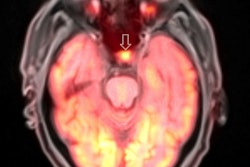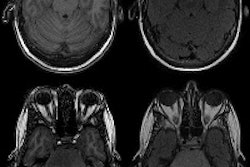Incidental findings on routine chest CT exams can be used to accurately predict risk for serious cardiovascular events, according to a just-published study in Radiology. Such findings could be preclinical signs of atherosclerosis and support an imaging-based model for risk prediction.
Dutch researchers started with a group of more than 10,000 patients without cancer or known heart disease who underwent routine chest CT for various indications. They tracked the outcomes over several years of those who had incidental findings on their scans. The researchers then developed a risk-prediction score based on the imaging scans -- a model they believe could someday be commonly used.
"The use of the score derived in this study is simple and quick and allows accurate stratification of individuals into clinically relevant risk categories and permits those at risk for [cardiovascular disease (CVD)] events in the near future to be distinguished," wrote Dr. Pushpa Jairam, PhD, and colleagues from University Medical Center Utrecht.
"Ideally, for every patient above the age of 40 years who undergoes a chest CT, a 10-year CVD risk can be calculated based on the imaging findings," Jairam added in an email to AuntMinnie.com.
Declining CVD rates
Rates for serious cardiovascular events have been declining for several years, thanks in part to tools such as the Framingham risk score that can predict heart disease risk in individuals who are asymptomatic. Clinicians are looking more carefully at risk factors such as age, sex, blood pressure, cholesterol levels, diabetes, and smoking status to better gauge the likelihood that an individual is at risk and needs further testing or treatment.
"Nevertheless, a substantial proportion of events occur in individuals without conventional risk factors or in subjects with undetected or underdiagnosed risk factors, leaving room for efforts to identify high-risk subjects through other ways than individual case findings by means of current risk strategies," the study team wrote (Radiology, May 27, 2014).
Because incidental findings are common in chest CT, tracking and scoring them offers a unique opportunity to detect the preclinical manifestations of atherosclerosis. The findings can be used to create a population-based screening approach to identify individuals at risk of cardiovascular disease events, according to the authors.
The baseline study cohort consisted of 10,410 patients who underwent diagnostic chest CT for a range of noncardiovascular indications (CT scanners ranged from two to 64 detector rows). Patients who experienced a cardiovascular event during follow-up were identified as cases.
Using a case-cohort approach, scans from the cases and a roughly 10% random sample (n = 1,366) of the full baseline cohort were graded visually for several cardiovascular findings; this comprised the study population. Finally, a total of 1,653 patients from a single hospital served as an independent validation cohort. In all, 211 events occurred in the validation cohort.
The final model included patient age and sex, CT indication, left anterior descending coronary artery calcifications, mitral valve calcifications, descending aorta calcifications, and diameter of the heart. It showed good discriminative value, with a C statistic of 0.71 (95% confidence interval: 0.68-0.74) and good overall calibration, as assessed in the validation cohort. That level is comparable to well-established cardiovascular disease prediction rules such as Framingham and Systematic Coronary Risk Evaluation (SCORE), the authors wrote.
The model did not reflect the validation cohort perfectly, as expected, and small differences emerged. For example, both coronary and aortic calcifications were seen more frequently in the validation cohort, but they were not more severe. Patient age and sex, the distribution of indications for CT, cardiac valve calcifications, and cardiovascular diameters were comparable between the two groups, Jairam and colleagues wrote.
| Patient factors that predict CVD risk | |
| Parameter | Hazard ratio |
| Male sex | 1.41 |
| Age | 1.03 |
| Hematologic malignancy | 0.72 |
| Mediastinal abnormality | 0.71 |
| Pulmonary malignancy suspected | 0.76 |
| Pulmonary embolism suspected | 1.03 |
| Other indication | 0.74 |
| Left anterior descending coronary artery calcifications | 1.11 |
| Descending aorta calcifications | 1.45 |
| Mitral valve calcification | 1.25 |
| Cardiac diameter -- 11 cm | 1.03 |
The model's predictive ability was high, the group found. Based on the risk levels predicted in the final model, 10% (n = 174) of patients were deemed low risk (< 10% risk), compared with 9% actual observed risk. A total of 37% (n = 616) were considered intermediate risk (10% to < 20% risk), compared with an observed risk of 12%. More than half (52%, n = 863) were deemed high risk (≥ 20% risk), versus an observed risk of 50%.
"Thus, the observed risks were similar to the risk predicted for each risk category for the final imaging-based model, indicating that the model could be used to accurately stratify individuals into clinically relevant risk categories," Jairam and colleagues wrote.
The value of incidental findings
The findings are consistent with previous studies showing the value of incidental findings in cardiovascular risk prediction, although those studies focused on the additive value of CT in risk assessment compared to conventional risk factors, the authors noted.
"We have taken a new perspective by providing a different approach for CVD risk prediction based strictly on information readily available to the radiologist," as conventional risk factors are generally unavailable, they wrote.
"Moreover, in many patients, risk factor detection earlier in the disease process precedes the presence of the image findings," they continued. "Therefore, the use of markers of subclinical target organ damage for CVD risk prediction, like cardiovascular calcifications incorporated in the imaging-based model, provides a novel strategy and adequate estimation of CVD risk, irrespective of the conventional risk factor status."
Also, the rise in chest CT use over the past two decades means that an imaging-based prediction rule could be a good way to implement a population-based cardiovascular screening approach, especially in at-risk populations such as smokers.
Using radiologic information could complement standard clinical strategies in cardiovascular risk screening and help improve the timely installment of cardiovascular risk management for eligible patients, Jairam and colleagues wrote. Even in individuals previously identified with conventional risk factors, the radiologic score could play a role in further CVD risk reduction, such as an elevated score triggering comprehensive lifestyle intervention and reassessment.
More research is needed, however, to assess the impact and cost-effectiveness of the method, and the effects should be evaluated in non-Dutch populations.
Current guidelines do not indicate prevention therapies for patients with subclinical organ damage determined with imaging techniques, without the presence of traditional risk factors, Jairam cautioned in his email.
"However, previous studies among individuals without modifiable risk factors demonstrated that those with subclinical organ damage detected with CT have significantly increased hazards for CVD events and mortality," the authors wrote. "In this regard, preventive treatment with statins and aspirin in patients with a high radiological score is considered to be appropriate, given the fact that the radiological score is based on markers of organ damage."
For their part, radiologists would need to shift their thinking somewhat to make screening work in routine practice.
"In current daily practice, there are certain challenges that need to be faced to make the implementation of routine use of the CT-based CVD risk score successful," Jairam said.
One challenge is that radiologists do not routinely use the radiological risk assessment tool in daily practice. Another is that referring surgeons do not routinely request and convey the CVD risk score with corresponding recommendations to the general practitioner.
"So the first essential step to improve successful utilization is extensive promulgation of the CT-based CVD risk score among radiologists and also other clinicians," he said, noting that the process is relatively simple.
"To calculate 10-year CVD risk with the CT-based risk calculation tool that we have developed, radiologists only have to semiquantitatively grade three cardiovascular findings -- left coronary calcifications, descending aorta calcifications, and mitral valve calcifications -- together with the heart diameter assessment," Jairam said. "In the future, I think these cardiovascular calcifications can be assessed with automatic software and the CVD risk score can be calculated fully automatically."




















